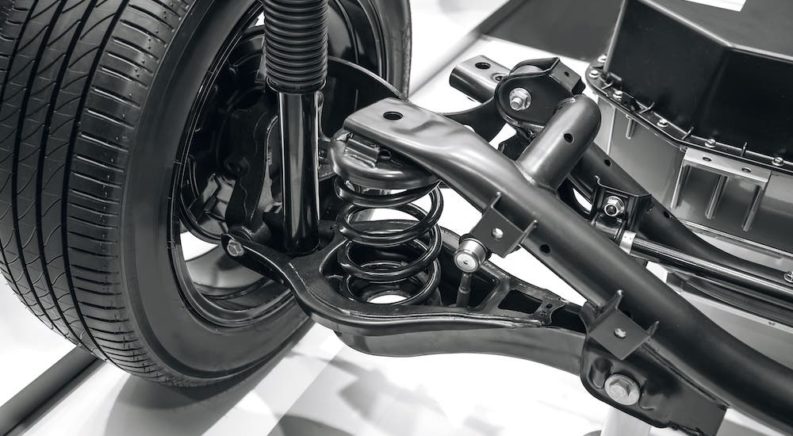The suspension system of your vehicle is very important. Not only does it provide you with a smooth ride that keeps you and your passengers comfortable, but it’s also connected to your steering system and ensures you’re able to maintain control over your vehicle. When something goes wrong with your suspension and steering systems, then you can find yourself in a really bad spot, especially if you lose control over your vehicle.
Fortunately, there are certain common warning signs that you can watch and feel for that will let you know that something has gone wrong with your suspension or steering system. Even better, a lot of the time, the problems that these signs are letting you know about are relatively inexpensive and easy to fix – regardless of whether you are up for the task yourself, or would rather have someone else do it. Like so many other aspects of proper vehicle care, the earlier you catch this stuff, the easier it is to take care of and keep your vehicle is in great shape. But if you ignore a problem, then it can become much more serious; this typically also means quite a bit more expensive.
#1 – Your Car Rides Much Rougher
The suspension system in your vehicle does a few different things, but one of the most important aspects of it is letting your vehicle comfortably adjust to bumps and dips in the road. Your suspension keeps your vehicle’s frame from being damaged by these things and absorbs shocks from uneven roads so that you’re not constantly being jostled and thrown around while you drive your vehicle. When it’s not working properly, however, then it’s quite common for your ride to become a lot less pleasant.
If you notice that your car rides rougher, which is to say that you feel a lot more bumps while driving, then that often means something is wrong with your suspension. In particular, it is a good indicator that your shock absorbers, which do exactly what their name indicates, are leaking or not working properly. It’s also possible that your struts are worn out – or that the springs in your suspension are damaged or no longer working well.
One simple way to check to see if there’s an issue with your shocks or struts is the “bounce test.” Park your vehicle in a level spot, put your weight on the front end of the vehicle to push it down, and then release. Your vehicle should only bounce once or twice, then settle. If it bounces three or more times, then it’s a good bet that you have a problem with your shocks or struts.
#2 – Your Car Pulls to One Side
The suspension and steering system of your vehicle is directly tied to your car’s alignment, which refers to how well it travels in a straight line with little input from you. On a smooth, straight road, your car should go forward in a fairly straight line without your constantly having to correct and adjust the wheel. That means your alignment is properly tuned, and your steering system is in good shape.
If you notice that your vehicle wants to pull to one side and that you’re constantly having to make little corrections to keep going straight, then you probably have a problem with your steering system and alignment. The easy way to test this is to find a smooth, straight road with no one else around and drive on it, taking your hands just slightly off the wheel. You’ll quickly notice if your car pulls to one side, or if it stays straight. Keep your hands close to the wheel and never do this while on a busy highway or at high speeds.

#3 – Your Car Becomes More Difficult to Steer
This is something that relies on you knowing your vehicle and how it performs. One of the most important things you can do as a driver is to learn the sounds and feel of your car after you buy it. You need to know what it feels and sounds like when normal, so you can detect when something is off.
Steering your vehicle should typically be pretty easy, especially if it is a modern model with power steering. If you notice that steering becomes more difficult, with your vehicle being less responsive or requiring more effort to turn, then something is wrong with your steering system or suspension. It could be something as simple as adding more power steering fluid, or it could be something more complex, but you want to take care of it as soon as possible.
#4 – Your Car is Sitting Lower on One Side or Corner
Every time you get into your vehicle, take a second to look it over and notice if anything seems off about it – take a little longer at least once a week to make sure it all looks good. If you notice that it is sitting lower on one side, or at one of its four corners, then that can mean something is off with your suspension. You want to make sure you’re parked on level ground, of course, or you might simply be resting in a pothole or on an incline.
#5 – Your Car Nosedives when Stopping
Much like #3 up above, this is something that depends on how well you know your vehicle. If you notice that the nose of your car dives downward when you stop, then that can mean there’s an issue with your suspension. It’s not unusual for you to be pushed forward in your seat when braking, especially suddenly, but the front end of your vehicle shouldn’t nosedive. If it happens, that means you need to have your frontend checked out.

#6 – Your Car Rolls when Cornering
Similarly, if you notice that your vehicle rolls to the side while you’re taking a corner, not just a little shifting but pretty extreme side-to-side shifting, then that can mean you have a suspension issue. That’s what I mean by “roll” here, not physically rolling over – that’s a much bigger issue, and your suspension is the last of your worries at that point. But if you notice your car is leaning intensely to the side when cornering, then you might have a suspension and steering problem.
#7 – Your Car Leans Back when Accelerating
While you will typically be pushed back into your seat when accelerating, your vehicle shouldn’t shift or lean backward in a similar way. If you notice that your car leans back when you accelerate, then that can mean your rear suspension system is compromised. The exact nature of the issue can vary, and if you’re taking your car for a lap around a race track, then you might notice some rear lean, but in daily driving, it shouldn’t lean backward.
Don’t Wait to Fix a Problem
The suspension and steering systems in your vehicle are not overly complicated, but they are vitally important to how your car rides and handles, and how well you can remain in control over it. Any time you notice something seems off, it’s best to trust your instincts and make sure any problems are taken care of right away. Adding fluid to your shock absorbers is pretty easy and not terribly expensive; replacing your suspension because it was damaged while driving on faulty shocks is a much bigger hassle.

